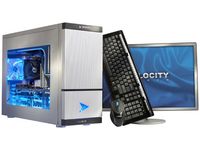Nvidia Launches Tesla Personal Supercomputer
Desktop supercomputers became a reality today as Nvidia announced the release of its new GPU-based Tesla personal supercomputer.
Nvidia and its partners have announced today the availability of the new GPU-based Tesla personal supercomputer. The Tesla personal supercomputer is claimed to offer up to 250 times the performance of a standard PC or workstation, yet remains small enough to sit on an office desk and plug into a standard power strip. The Tesla personal supercomputer is made possible in part to Nvidia’s CUDA parallel computing architecture, where GPUs and CPUs work in tandem to greatly enhance the performance of complex, data-intensive computations.
At the heart of the new Tesla personal supercomputer are three or four Nvidia Tesla C1060 computing processors, which appear similar to a high-performance Nvidia graphics card, but without any video output ports. Each Tesla C1060 has 240 streaming processor cores running at 1.296 GHz, 4 GB of 800 MHz 512-bit GDDR3 memory and a PCI Express x16 system interface. While typically using only 160-watts of power, each card is capable of 933 GFlops of single precision floating point performance or 78 GFlops of double precision floating point performance.
While the Tesla C1060 computing processors are powerful, they have a massively-parallel architecture that may have trouble with serial computing modes. The Tesla personal supercomputer also features a powerful Intel or AMD quad-core processor, which is another important component of the system, especially when dealing with these serial computing modes. The Tesla personal supercomputer includes at least 4 GB of system memory per included Tesla C1060 card and at least a 1200- to 1350-watt power supply. System noise is rated at less than 45 dbA and the supported operating systems include Windows XP, Red Hat and SUSE.
It is pretty clear that the Tesla personal supercomputer is not designed for PC gaming, but rather for highly computational research and professional work. Ideal types of applications for this system would likely include the processing of large sets of consistent data, such as transcoding a DVD or studying seismic activity. The GPU-based Tesla Personal Supercomputer is now available from retail HPC OEMs, system builders and resellers, including Dell, Asus, Western Scientific and Microway. Prices vary depending on configuration, but expect to pay around $10,000 for your own personal supercomputer.
Get Tom's Hardware's best news and in-depth reviews, straight to your inbox.
-
sgtbaker420 Cool, That's a LOT of raw power. Could this be re-configured to chunk through games??? Use the number crunching power of this unit like a processor and then run it through some high end video cards. If it has 4gig sys.ram/card that could blaze through some Fallout3-FarCry2-Crysis.Reply
Anybody got 10g's I can "borrow"? -
kschoche These cards are basically just older Nvidia gaming cards with more memory, I think its just the 200 series chips. Yeah, assuming you had a way to address all of that space properly, and had a video out, they would be able to game, but thats again, not the point of this machine.Reply -
Tindytim thogromI wanna see some benchmarks xDPlease?Reply
Maybe for Christmas? Present for the readers? -
kschoche thogromI wanna see some benchmarks xDBenchmarks of what?Reply
Number crunching? All you're going to get is the same PR results at the very best: 900GFlop SP, 93GFlop DP
These dont have video outs, so good luck getting anything else. -
mikepaul I sure hope my personal economy is doing OK around tax return time, so I can spring for the best GTX 280 shipping at that time. I'd settle for one decent GPU to play with CUDA programming...Reply -
antilycus for For my 3d rendering needs in I cant see anything so I apologize in advance for any typo's. This is huge news as 3d rendering nuts, such as myself would love it. too bad I could never afford it. But I am sure Newtek's Lightwave and maya would love it.Reply -
hello to you all, i was wondering that anyone actually bought this and test it.Reply
I am particularly interested to use it to render in 3D Studio MAX for animations or similar and if someone test this please place a comment.
Thank you.
